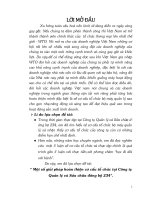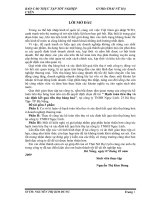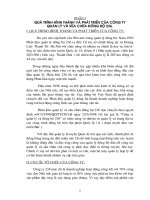E9 Week 23
Bạn đang xem bản rút gọn của tài liệu. Xem và tải ngay bản đầy đủ của tài liệu tại đây (126.87 KB, 4 trang )
<span class='text_page_counter'>(1)</span>Week: 23 Period: 45. Date of preparing: 23/ 01/ 2016 Date of teaching: 25/ 01/ 2016. UNIT 7: SAVING ENERGY Lesson 2: SPEAK AND LISTEN I. OBJECTIVES: Teaching aims: By the end of the lesson, Ss will practice making and responding to suggestions about saving energy, listen for gist and specific information. II. PREPARATIONS: book, cassette tape III. PROCEDURES: *Checking attendance (1’): - 9A1:………………………………………………… - 9A2:………………………………............................ - 9A3:…………………………………………………. Teacher’s activities 1. Warm – up: (5’) - Have Ss play game “Whisper” Ex: Everybody must save energy by turning off the light when unnecessary. 2. Pre - speaking (12’) - Have Ss look at picture and answer some questions 1. Which room is it? 2. Are the lights on or off? 3. Is the TV on? 4. Who is watching TV? 5. What should we do save energy?. - Introduce the ways of making and responding to suggest Suggestion Respond I suggest +V-ing That is a good idea How about +V-ing All right What +about +Ving No, I don’t want to… I think we should… I prefer to +V-inf Why don’t we…? Let’s +V-inf I suggest that….. 3. While - speaking (10’) - Have Ss look at the pictures/page 59 - Make model T: I suggest we should take a shower instead of a bath. Ss: That’s a good idea. - Have Ss make suggestion and respond - Call Ss to practice in front of class. b/ I think we should turn off the gas fire.. Students’ activities Group work.. - Listen and answer the questions It’s a living room They are turn on Yes, it’s. Nobody I think we should turn off the TV I suggest turning off the lights - Write down.. - Look at the picture. - Listen. - Work in pairs. - Present their answers..
<span class='text_page_counter'>(2)</span> c/ I suggest turning off the fan. d/ What about turning off the air conditioner when no one is in. e/ Why don’t we turn off the TV when no one watches it. f/ I think we shouldn’t go to school by motorbike. g/ Let’s go to school by bus or bicycle. 4. Post - speaking (15’) - Ask Ss write down your suggestions to save energy for your class - Call some Ss to read the answer. - Explain new words: + Nuclear power (n) + Solar energy (n) + Solar panel (n) + Install(v) = put + Effective (adj) = good - Set the scene: you are going to listen some information about solar energy. - Have Ss predict T/F statements/page - Have Ss listen to the text and check their prediction - Call Ss to get feedback. * Answer key: 1-T, 2-F, 3-F, 4-T, 5-F - Have Ss listen again and complete the blanks/page 60. - Pair works. - Read the answer. - Guess the meaning of new words. - Listen to the teacher. - Work in pairs. - Listen to the tape and check. - Give the answer. - Listen again and complete the blanks. - Compare with their partner. - Call Ss to get feedback Answer key: 1. effective 4. store 2. pollution 5. roof 3. countries 6. instead 5. Homework: (2’) -Ask Ss write down your suggestions to save energy at home Take note. Prepare lesson: Unit 7 – Read/ p. 60 IV. COMMENTS: ........................................................................................................................................................... ........................................................................................................................................................... ________________________________ _________________________________. Week: 23 Period: 46. Date of preparing: 25/ 01/ 2016 Date of teaching: 27/ 01/ 2016. UNIT 7: SAVING ENERGY Lesson 3: READ.
<span class='text_page_counter'>(3)</span> I. OBJECTIVES: Teaching aims: By the end of the lesson, Ss will be able to practice reading about saving energy for details, know how North American and European countries saving money and natural resources. II. PREPARATIONS: Book, cassette tape III. PROCEDURES: *Checking attendance (1’): - 9A1:………………………………………………… - 9A2:………………………………............................ - 9A3:…………………………………………………. Teacher’s activities 1. Warm - up (5’) - Have Ss answer the question: Where can we get electricity? Coal Oil. Students’ activities - Work in individual - Answer the questions. Electricity. Tidal waves. wind water 2. Pre - reading (15’) - Introduce some new words: 1. Consumer (n) 2. Luxury >< Necessity (adj) 3. Account for (v) 4. Tumble dryer (n) 5. Bulb(n) 6. Scheme(n) 7. Category(n) 8. Innovation(n) 9. Conserve(v) 10.Ultimately(adv) - Have Ss practice the new words - Have Ss guess which statement is true ,which statement is false 1. In western countries, electricity, gas and water are luxuries 2. An energy saving bulb costs less electricity than an ordinary bulb. 3. Saving energy bulbs use a half of the electricity of standard bulbs 4. The labeling scheme helps the consumers know how much energy efficiency each model has. 3. While - reading (14’) - Have Ss read the text and check their prediction.. - Guess the meaning. - Practice the new words - Work in pair to guess the statements. - Read the text and check their prediction.
<span class='text_page_counter'>(4)</span> - Call Ss to get feedback. - Have Ss read the text again, answer the questions /p. 61 - Get feedback Answer : 1. They are interested in products that will not only work effectively but also save money. 2. they can use energy saving bulbs instead of ordinary 100 watts bulbs 3. she will pay US $ 2 4. It helps the consumers know how energy efficient the household appliances are. 5. Because when we save energy, we’ll save money and conserve the earth’s resources. 4. Post - reading (8’) - Have Ss discuss the question. - Answer: 1-F, 2-T, 3-F, 4-T - Group work. - Give feedback.. - Work in group to discuss the questions. Ways to spend less on - Get feedback. - Present their answers.. 5. Homework (2’) - Ask Ss write a passage about ways to save energy. Take note Prepare lesson: Unit 7- Write/ 61 IV. COMMENTS: ........................................................................................................................................................... ........................................................................................................................................................... _________________________________ _________________________________.
<span class='text_page_counter'>(5)</span>



